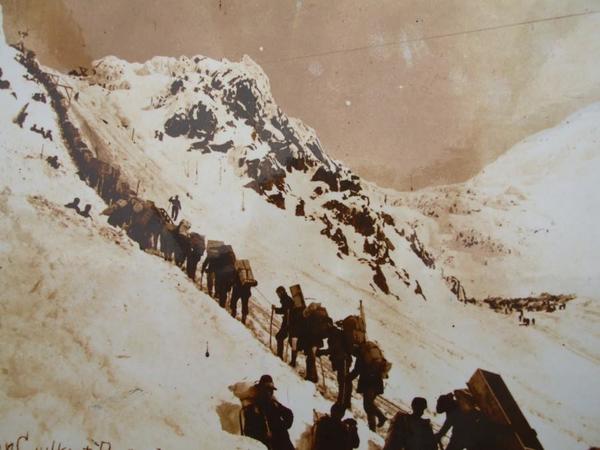Where frenzied Gold Rushers once dragged themselves and their equipment on foot over the Chilkoot and White Passes, the White Pass and Yukon railroad offers comfortable 3-hour excursions in restored 1890s-era coaches.
But it wasn't built just for pleasure; in 1898, when construction started, it was a vital way to cross the mountains and enter Canada's Yukon Territory, where the gold (or hopes of it) was. It took $10 million, thousands of workers and 450 tons of explosives to finish the 26-month project. Was it worth it? The picture below shows the alternative.
Oh, by the way: Canada would only let you in if you had a ton of supplies to last you over the winter. That meant climbing the trail over Chilkoot or White Pass 35 to 40 times. A lot easier this way, eh?
We took the ride as a shore excursion with our tour group, Steve Spangler's Science at Sea, cruising on the Nieuw Amsterdam, traveling on the lower part of the route, from Skagway, Alaska to Summit Lake on the U.S.-Canada border. The line continues into Canada as far as Carcross, where there's a bus transfer to Whitehorse, the Yukon capital. The railroad used to go all the way, but the last leg is now by highway.
Skagway, despite its importance in Gold Rush days, is today a small town with a permanent population of 800 or so, but in the summer, when the cruise ships come, two and three at a time, the population zooms into the thousands, and summer workers appear to serve the crowds.
Leaving Skagway, from near the depot, we soon came to the WP&YR's maintenance area, with one of its old steam engines parked outside. These days, all but a few excursion trains are hauled by modern diesel-electrics, though. And we passed these two sheds which are the local presence of the U.S. Customs and Border Service.
Once outside the town, the scenery got more breathtaking, and a rotating crew of travelers took to the outside ends of the cars for pictures. Funny, how no tourist railroad or boat seems to have considered clean windows and possibly non-reflecting glass...but I digress.
As you might imagine for a railroad that climbs 3,000 feet in 20 or so miles but ends up only about 7 miles away from Skagway as the crow flies, there are a lot of opportunities for seeing yourself going around a curve.
At one point, you can even look back through a gap in the trees and see all the way back to Skagway; unfortunately I was on the wrong side of the train at the time!
Lest you be confused about what's what, the railroad has a selection of, well, terse descriptions.
The Gulch sign is at the old trestle bridge. When it was erected, it was the highest drop trestle bridge in North America. It continued in use until the 1950s, when new diesel engines were too heavy for it. Building a new tunnel to bypass it proved cheaper than re-building the bridge.
And here are the two tunnels, one from 1898 and the other from the 1950s. The wooden shed isn't the tunnel's structure, which was blasted through rock. It's there to keep snow from filling the tunnel mouth, although the railroad no longer operates in the winter. The building of the Klondike highway in the 1970s and a decline in prices for Yukon minerals ended the WP&YR's freight business and most of its passenger traffic, turning it into a summer attraction that is one of Alaska's most popular shore excursions.
Summer is also the maintenance season, and a crew was out and about with this gasoline-powered 'doodle-bug' and trailer.
A reminder of past times: Near the summit, we passed this sign, which marks a still-visible bit of the narrow path the would-be miners trekked. Another reminder of the Trail of '98: The U.S. portion of the Klondike Highway is designated as Alaska 98.
At the summit, we passed the U.S.-Canada border, which is set along the tops of the coastal range. Originally, British Columbia's claim ran to the base of the mountains, while the U.S. claimed some areas on the eastern side. It must have seemed an important issue at the time, but nobody's paying attention at the unmanned crossing today.
Summit Lake is one of a chain of lakes that feed the headwaters of the Yukon River at Whitehorse. Before the railroad, prospectors needed to build or buy barges and when Spring thawed the way, head down the chain of lakes to the river and beyond.
Our excursion turned around at the summit for the return to Skagway...no leaving the train because we were 'in transit' in Canada, and no one to check our papers! Here's our locomotive, which passed the train to reconnect at the other end.



Comments (3)